Diary of a Brand: Blank Street CoffeeBlank Street isn’t a coffee shop. It’s a thesis on the future
I found out about Blank Street Coffee on Twitter.
Specifically, NYC-based friends tweeting that they were trying the coffeeshop that had appeared seemingly out of thin air.
And appear it has. After its founding in 2020, Blank Street now has north of 50 locations across NYC, London, Boston and DC, with ambitions to expand into the hundreds. Fortunate timing (many prime locations were vacant thanks to COVID19’s impact on hospitality) and a hefty fundraise (BSC has raised $67M from VC funds including General Catalyst and Tiger Global, real estate giant Tishman Speyer, and the founders of Allbirds, Harry’s, and Warby Parker) fueled much of that growth.
On the outside, Blank Street appears to be a modern coffeeshop. What makes Blank Street worthy of such rapid expansion?
Blank Street’s vision: somewhat cheaper coffee.
According to Blank Street, the brand’s founders Issam Freiha and Vinay Menda (who happen to be venture capitalists themselves) created the brand with a simple mission: to make good coffee cheaper.
“I noticed my friends going to Starbucks for the convenience, Dunkin’ for the price point, and specialty coffee shops for the quality. But as students, we couldn’t afford a $6 cappuccino every day. What we needed was a one-stop shop: a place to get exceptional coffee at an accessible price point, crafted with speed and efficiency.” — co-founder Issam Freiha — QSR Magazine
Source: Blank Street’s homepage
I can attest to the growing cost of a latte. But is Blank Street actually cheaper than other NYC staples? I could not help but indulge in a bit of coffee drinking research.Source: over-caffeinated author
Alright, BSC is a bit cheaper. But the idea that a $.75 savings is enough to democratize good coffee feels like a stretch. A twice daily $4 cappuccino is still an indulgence. As a side note, the real savings looks to be in forgoing alternative milk.
Starbucks designed for the new generation
To me, the brand feels less like affordable cafe, and more like Starbucks redesigned for Gen Z. The brand offers the playful, pastel flat design, popularized by disruptive consumer brands from Away to Starface. The core light green brand color is even a nod to Starbuck’s deep green.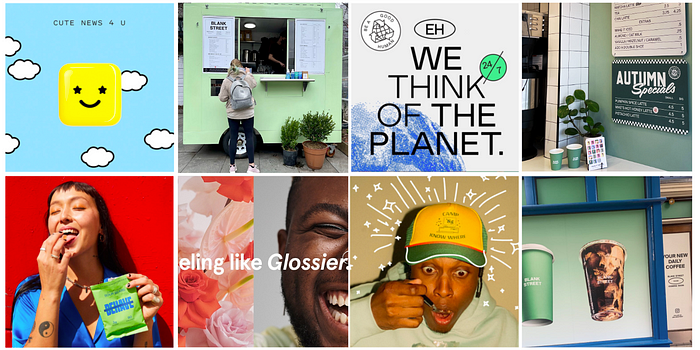 Flat design, pastels, and text encircled by ovals. Blank Street fits right in to Gen Z’s ‘adorkable’ brand aesthetic as coined by Ben Schott
Flat design, pastels, and text encircled by ovals. Blank Street fits right in to Gen Z’s ‘adorkable’ brand aesthetic as coined by Ben Schott
Comments on New York Times article, ‘It’s Not Just You — Blank Street Coffee Is Suddenly Inescapable’ relay a similar sentiment:
Just pick your favorite millennial-approved pastel and Helvetica-adjacent font and you too can have a venture capital backed business that no one asked for!! Because what the world (see: New York) really needs, after all these years of small businesses shuttering, is yet another generic franchise slanging an over-priced, sub-par product amid fiddle leaf figs (ooooh), pastel tiling (ahhhh), and brass fixtures (woooooow). Looking forward to the day this busts.
Brand growth via Partnerships
Blank Street has taken a page from the direct-to-consumer marketing playbook by partnering with influencers and other trending brands to garner attention, including sunscreen brand Supergoop!, Kendall Jenner’s 818 Tequila, YouTuber Emma Chamberlain’s Chamberlain Coffee, and cult ingredient Mike’s Hot Honey. Partnerships are a key tenet of Blank Street’s awareness strategy. Source: Blank Street Instagram
Partnerships are a key tenet of Blank Street’s awareness strategy. Source: Blank Street Instagram
Next to Starbucks, BSC and its cadre of brand partners feel youthful, modern and fresh. But not necessarily authentic. It feels a bit like commoditized marketing. Eater penned their own opinion piece on BSC this summer, calling the brand “oppressively blah:”Source: Eater
With the name ‘Blank,’ the lack of personality kind of fits. But branding aside, what is fascinating about BSC is not its brand color, but its business model.
Blank Street’s new model for coffee: cheap, tech-enabled pickup
Great organizations work when brand proposition and company operations fit. IKEA’s flat pack furniture, out of city locations, and reliance on customers to assemble goods allow IKEA to save costs and invest in a killer offering of good design at low prices.
When I grade brands, I use a model that tests the link between brand proposition (what the brand supposedly stands for), product offering, and price, along with the underlying business operations to see if a reinforcing structure exists: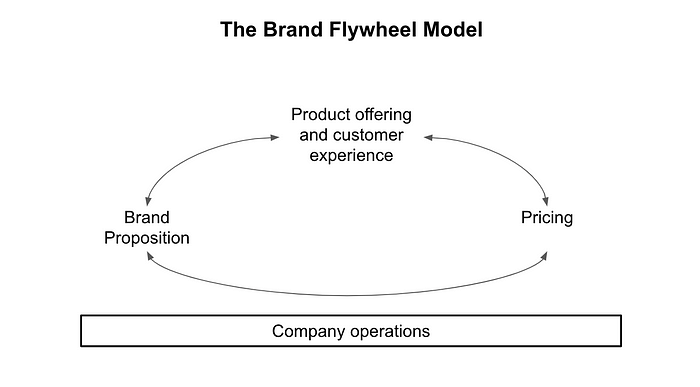 Source: Michelle Wiles
Source: Michelle Wiles
Starbucks works because its service-heavy offering aligns to its brand mission of nurturing the human spirit, while premium prices and optimized processes uphold their fairly expensive operations and large format locations. The price also lends a bit of luxury to the holder of a Starbucks latte.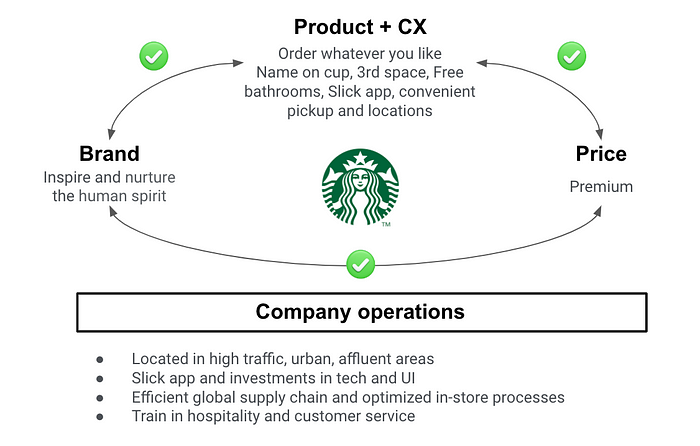 Starbucks Brand Model. Source: Michelle Wiles
Starbucks Brand Model. Source: Michelle Wiles
Blank Street has designed its operations to support its offering of affordable coffee to on-the-go urbanites.
Unlike Starbucks’ ‘third space,’ Blank Street’s locations tend to be small, designed largely for pickup (and cheaper rent).
Blank Street’s real estate savvy includes plans to partner with landlords to rent just the front portion of larger spaces, leaving the back area for other new-economy renters like warehouses and ghost kitchens. Already, founders Menda and Freiha employ real estate tricks like setting up their NYC carts on private land, which makes them exempt from NYC permitting limits (Source: Grub Street).
The startup then minimizes labor costs by investing in tech. Each BSC comes with an Eversys espresso machine, costing upwards of $20,000. These machines prepare a latte at the press of a button, meaning Blank Street only needs 1–2 baristas at a time, and baristas don’t necessarily need much prior experience in coffee.
“Between the Eversys machines and a mobile order-ahead app, Blank Street’s locations can run smoothly with just one or two employees, not five or six.
- Grub Street
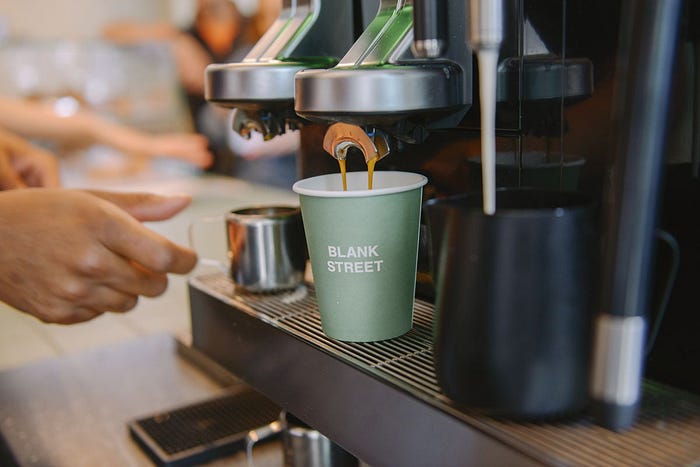 Blank Street’s push-of-a-button operations. Source: Eater
Blank Street’s push-of-a-button operations. Source: Eater
The low cost real estate + tech-enabled operations seem to be working so far.
A 2021 Grub Street piece reported that every Blank Street location is profitable, with the first location earning back its initial investment after just eight months.
It’s clear that Blank Street is a very different organization than Starbucks. Starbucks is an experience. The name on the cup, the free bathrooms, the endless customizations. In contrast, Blank Street is a tech and real estate company, optimized for quick pickup and a get-in, get-out mentality.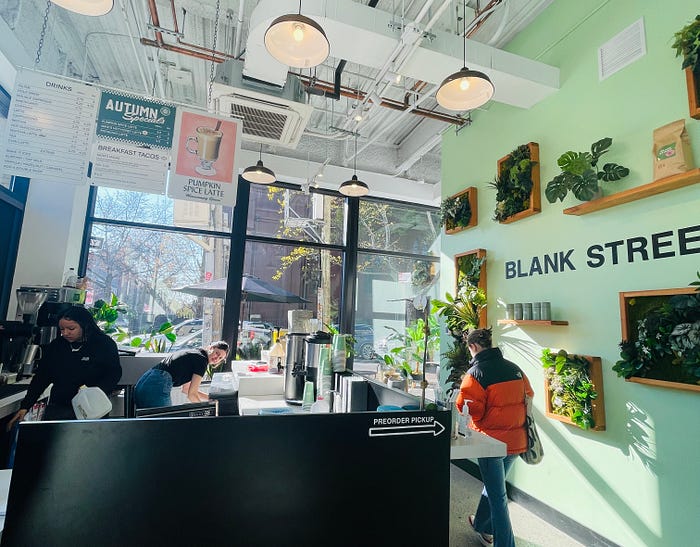 Blank Street’s Downtown Brooklyn outpost. Source: Author
Blank Street’s Downtown Brooklyn outpost. Source: Author
However, the brand model does not totally fit. As mentioned, the “low price” proposition feels incongruous with the in-reality premium prices and modern store experience: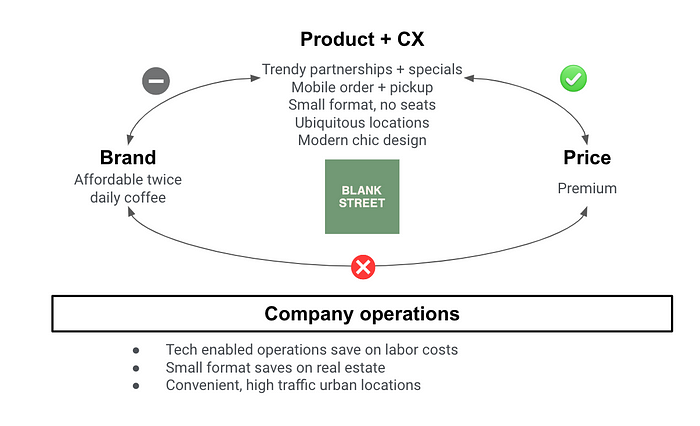 Blank Street’s premium prices and experience clash with its proposition. Source: Michelle Wiles
Blank Street’s premium prices and experience clash with its proposition. Source: Michelle Wiles
Matto, another coffee chain that has expanded across NYC with small format coffee shops and an emphasis on low prices has a much tighter brand model. Unlike BSC, Matto is actually cheap. They offer flat $2.50 prices on everything (yes, everything), and have not fallen prey to BSC’s venture capital “blah” branding. Their old-school, graphic-design-is-my-passion aesthetic actually matches well with a value pricing model.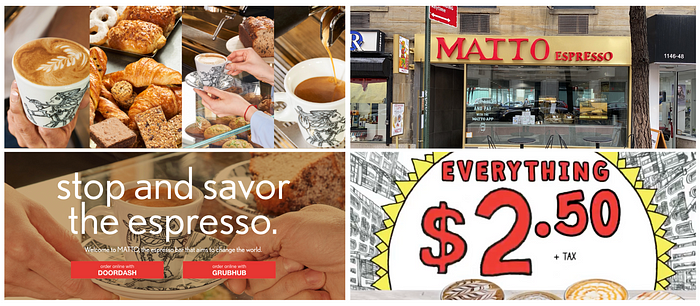 Matto has almost 30 NYC locations. Source: Matto
Matto has almost 30 NYC locations. Source: Matto
Matto’s brand model is self-reinforcing, and imply it is in the low-price, high-volume business: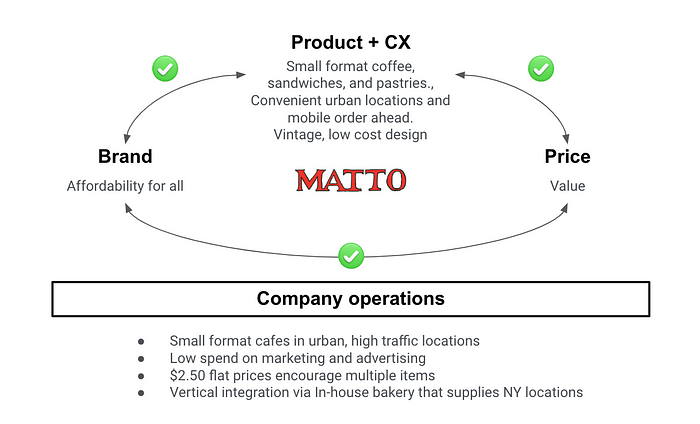 Source: Michelle Wiles
Source: Michelle Wiles
From Blank Street Coffee to Blank Street Everything
What if coffee is not Blank Street’s endgame?
BSC’s emphasis on partnerships might serve as a savvy marketing strategy, but it might also be a window into Blank Streets true ambitions: the everywhere quick pickup shop of coffee, tacos, sunscreen, and more.
In essence, Blank Street is not a coffee shop, it’s a platform. And Starbucks is not the competition. At least not in the future. Blank Street could compete with DoorDash, quick delivery startups, and even the Facebook/Meta ad platform. Hear me out.
Urban delivery is a VC dream that has proven tough to turn profitable, in part because of the high cost of last-mile delivery.
What if, instead of delivering items to you, a company offered an array of convenient pickup locations for you to grab your goods?
In the same way that Amazon began with books, Blank Street’s start in coffee reflects a way to get embedded as an app and build trust among consumers. The name Blank Street implies a “fill in the blank” potential to pick up just about anything. Their value will come from convenience and curation.
Blank Street is already pursuing this in small ways. They stock King David Tacos under a program titled ‘Powered by Blank Street.’ Tacos work well for pickup because they can be packaged and held on site for pickup easier than say, custom Sweetgreen salads. Blank Street could offer an array of different food and convenience items at different times of day and year for quick order and pickup.
But there’s a second option...
What if Blank Street becomes the IRL platform for brands to grow awareness?
Blank Street’s partnership model is a kind of real life advertising platform. And it could easily expand as brands look for new avenues to grow. Magic Spoon could sample cereal through a 2-week breakfast collaboration with Blank Street. Away could take you to new destinations with location-themed coffee specials. Blank Street could also use its real-estate savvy to help brands break into physical retail with unique spaces, by serving as the operational partner.
Per Blank Street’s LinkedIn, the company has hired multiple team members from direct-to-consumer brands Away and Supergoop, as well as fast delivery startups Jokr and Zapp. That may be coincidence. But Blank Street’s brand model is less contradictory if they lean into their partnerships and design instead of affordability.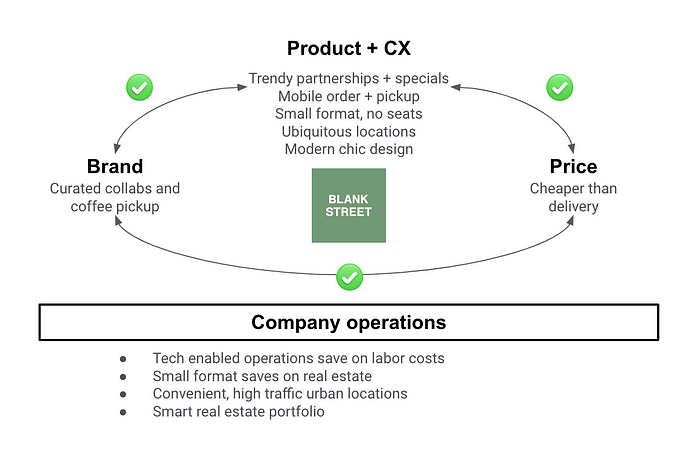 Blank Street’s future model? Source: Michelle Wiles
Blank Street’s future model? Source: Michelle Wiles
What about Blank Street’s brand proposition?
Platform status aside, BSC currently lacks a strong brand idea as a coffeehouse. ‘Affordable’ lacks the panache of other coffee brands, and Blank Street’s roots in ex-venture capital founders make the story feel disingenuous.
Coffee is like a fashion item: it says something about you. Walking around with cup from an expensive 3rd wave cafe might signal taste. Coffee from a bodega might signal an authentic NYC attitude. Depending on who you are, Starbucks might signal premium taste, or a lack thereof.
What does a Blank Street cup say? According to The New York Times, Blank Street is “an avatar of gentrification and automation.” Not the ideal association one might want to have walking around the city.
Blank Street might consider investing in a brand campaign that leans into a future people want to be part of. Tech companies like Amazon and DoorDash are creating campaigns to shift their perception to worker friendly organizations. BSC publicly pays its baristas $23/hr. A brand mission around being future forward and paying workers well (especially when Starbucks faces labor problems) could be a smart positioning.
If Blank Street does venture into a role as a ubiquitous urban pickup platform, or an in-real-life brand catalog, Blank Street could own a space of innovation, being on-trend, and small-business engagement. Something people can feel good about. So when you walk into a meeting with a BSC cup… you have a statement. You’re someone people want to be.
The future of Blank Street
Bloomberg reported that Blank Street is raising new funds at its same valuation, which may hint at cost troubles at the company. I’ve been to Blank Street three times, two of which I got my coffee free due to promotion. That’s not the best sign.
On the other hand, their growth is impressive, and they have clear avenues to scale from coffee purveyor to real estate-based platform. A bit of investment in linking their brand and unique operations will help them get there.
Don’t miss out on brand insights — Sign up for monthly emails on brand marketing.
Looking for help growing your brand?
I run brand consultancy Embedded — where I partner with founders and C-suite executives to unlock brand growth.
Not sure where to start? Many clients opt for ad-hoc coaching — hourly consultations on any aspect of your marketing and brand strategy. Get in touch here, or book a 15 minute free consultation.































































